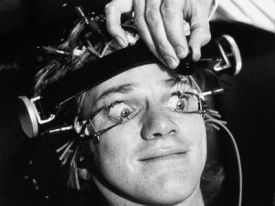
Midway through a series of thoughts on gluttony, violence, numbness and the Network, I found myself leafing through Robert Pinsky’s verse translation of The Inferno of Dante:
Midway on our life’s journey, I found myself
in dark woods, the right road lost. To tell
About those woods is hard—so tangled and roughAnd savage that thinking of it now, I feel
The old fear stirring: death is hardly more bitter.
And yet, to treat the good I found there as wellI’ll tell what I saw, though how I came to enter
I cannot well say, being so full of sleep
Whatever moment it was I began to blunderOff the true path…
The train of thought started with the asymmetric publish-subscribe social network model popularized by Twitter. In a symmetric model, there must be assent by both parties for a connection to be forged. In an asymmetric model, a person may follow an unbounded number of other people. Like a kid in a candy store, we greedily subscribe to this one and that. Oh, and the one over there looks very interesting. Our virtual stomachs and appetites have an unlimited capacity.
As we sit back to digest the stream of messages, we find ourselves looking into the business end of a firehose. Each person we subscribe to may produce a manageable flow, but if we aggregate all these messages and make them march single file through a small opening the velocity becomes violent. The senses are pummeled with a raging torrent of voices from all quarters of the globe.

The response to a violent overstimulation of the senses is numbness and withdrawal. It started out so innocently, a few friends gather round a bar and swapped one liners. Every joke was heard, and each built on and referred to the previous one. Now the messages move by so quickly we can barely grasp the words they contain. We grow numb, distant, we hold the stream at arms length, our emotions disengage.
What does the defender against this battering look like? Is he the one who decries this new-fangled firehose of messages? Dismisses it as unneeded, as superfluous? The one who lovingly points to the old ways and speaks eloquently of their sufficiency?
Or perhaps it is the one who points the way, showing us evidence of a path that seems to lead over the horizon. Telling of us of a wondrous time and place where the new technology is perfectly integrated—all friction resolved. The one who expectantly points to what is absent and asks us for our present for the sake of the future.
If media is an extension of our central nervous systems; if these subscriptions are extensions of our eyes and ears, our sense of touch— then each of these sensors serve to collect impressions, translate them into words, images and sounds and relay them back to us.
But when we first come upon them we don’t recognize them as parts of ourselves. Perhaps we see them as just another commodity in the corporate marketplace of entertainments—an amusement to occupy our time. Sense organs detached, packaged, and sold back to us on a subscription model.
At this present moment, we walk like a drunkard, numb to the world around us, filled to the gills with firewater and lurching to and fro. We promise we’ll only dip in from time to time. But we find ourselves, eyes glazed, mouth open, staring at the flow racing through the glowing rectangle. Unable to comprehend, unable to pull ourselves away. Comfortably numb.
What would it look like if we used those subscriptions as purposeful extensions of our senses? Our senses serve us as we navigate and discover the spaces of the Network. We share, create and connect. We might extend our senses through subscriptions to those with whom we share an affinity. The shape and value of the social graph would be measured not by its sheer size, but rather by its sensitivity to our circle of concerns. Is there a road we can travel to reconnect to our own sensibilities?
Comments closed…This hollow where we stand. There is below
As far from Beelzebub as one can beWithin his tomb, a place one cannot know
By sight, but by the sound a little runnel
Makes as it wends the hollow rock its flowHas worn, descending through its winding channel:
To get back up to the shining world from there
My guide and I went into that hidden tunnel;And following its path, we took no care
To rest, but climbed: he first, then I—so far,
Through a round aperture I saw appearSome of the beautiful things that Heaven bears,
Where we came forth, and once more saw the stars.
